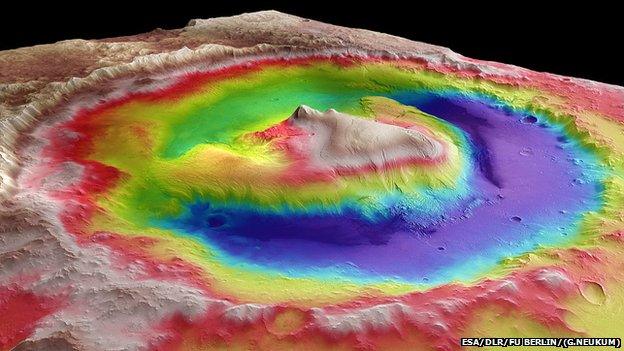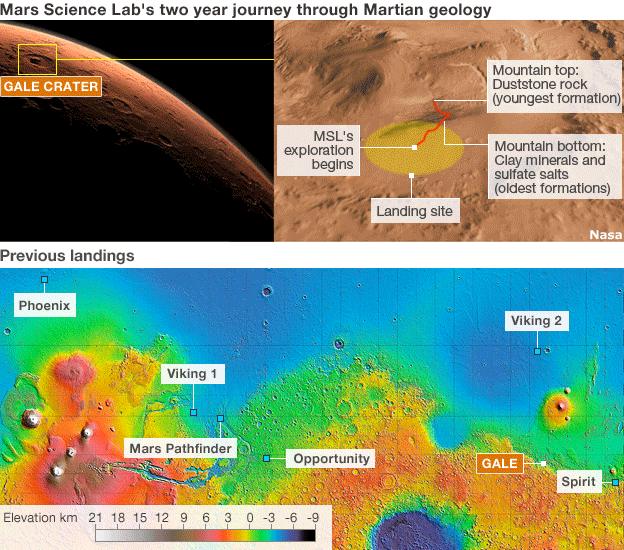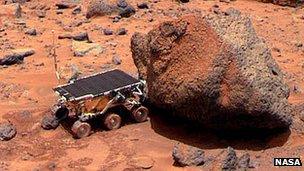MSL-Curiosity: Biggest Mars mission yet
- Published
- comments

An elevation model of Gale crater made using data from Europe's Mars Express orbiter. MSL lands on the lower, nearside of the central peak, which rises more than 5km above the crater floor
The delivery of Nasa's Mars Science Laboratory rover, external, known as Curiosity, to the surface of the Red Planet is a mouth-watering prospect.
The $2.5bn robot is by far the most capable machine ever built to touch another world. Consider just the history of wheeled vehicles on Mars.
In 1997, the US space agency put the toy-sized Pathfinder-Sojourner, external rover on the surface. It weighed just over 10kg.
This was followed seven years later by the 170kg, twin rovers Opportunity and Spirit, external. Their instrument complement combined (5kg + 5kg) was equal to the total mass of Sojourner.
Now, we await Curiosity - a 900kg behemoth due for launch this Saturday. Its biggest instrument alone is nearly four times the mass of that teeny robot back in '97.
"It's the size of a Mini Cooper with the wheelbase of a Humvee," is how project scientist John Grotzinger describes the rover.
So, we're expecting great things from Curiosity. A big machine to address some big questions.
Mike Meyer is the lead scientist on Nasa's Mars exploration effort: "MSL plays a central role in a series of missions of looking at Mars and determining whether or not it has the potential for life. It is capable of going to a region and exploring that region, and telling us whether or not it has been, or may even still be today, a habitable place - something that could support microbial life."
Engineers have designed a new entry, descent and landing system they say can put the roving laboratory down on a button.
OK, so this button is 20km wide but the accuracy being promised is an order or magnitude better than previous technology, and it has allowed researchers essentially to go where their heart desired.
They've chosen a near-equatorial depression called Gale Crater. It's one of the deepest holes on Mars - deeper even than Valles Marineris, that great scar that tears across one quarter of the planet.
Scientists believe Gale will be the geological equivalent of a sweet shop - so enticing and varied are the delights it appears to offer.
"This crater is about 100 miles across and it has a central mound that's about three miles high," explains Grotzinger.
"The important thing is that the central mound is a series of layers that cut across the history of Mars covering over a billion years. So, not only do we have high-resolution images showing we have layers in this mound, but also because of the spectrometers we have in orbit flying around Mars, we can see minerals that have obviously interacted with water."
The intention is to put MSL-Curiosity down on the flat plain of the crater bottom. The vehicle will then drive up to the base of the peak.
In front of it, the rover should find abundant quantities of clay minerals (phyllosilicates) that will give a fresh insight into the very wet, early epoch of the Red Planet. Clays only form when rock spends a lot of time in contact with water.
Above the clays, a little further up the mountain, the rover should find sulphate salts, which relate to a time when Mars was still wet but beginning to dry out. Go higher still, and MSL will find mostly the "duststones" from the cold, desiccated world that Mars has now become.
But even before all this, MSL will land on what looks from orbit to be alluvial fan - a spread of sediment dumped by a stream of water flowing down the crater wall.
If the science on this fan proves productive, it could be many months before MSL gets to the base of the mountain.
The rover has time, though. Equipped with a plutonium battery, it has the power to keep rolling for more than 10 years - time enough to scout the crater floor and climb to the summit of the mountain.

"We are not a life detection mission," stresses Grotzinger.
"I know that many of you would like to know when we're going to get on with doing that. But the first and important step towards that is to try to understand where the good stuff may be. And in this case a habitable environment needs to be described.
"This is an environment that contains a source of water, which is essential for all life as we understand it on Earth; we need a source of energy, which is important for organisms to do metabolism; and we also need a source of carbon, which is essential to build the molecular structures that an organism is composed of."
You may be wondering why these sorts of missions don't look directly for life, and the reason is pretty straightforward. Those types of observations are actually quite difficult to make, and the truth is we don't really expect to find microbial communities thriving at the surface of present-day Mars. The conditions are simply too harsh.

Little one: the Sojourner rover now looks like a toy compared to MSL
But go back further in time, and the situation may have been very different. It seems pretty clear now that when life was getting going on Earth more than three billion years ago, conditions on Mars were also warm and wet.
But the traces of those ancient lifeforms on our own planet are now very hard to read, and often require instruments that would fill a room. Not even a machine the scale of Curiosity could carry them.
So, MSL will restrict itself to the habitability question, and it will do this using a combination of 10 instruments.
The rover has instruments on a mast that can survey the surroundings and assess potential sampling targets from a distance. These include cameras and an infrared laser system that can excite the surface of a rock to betray some of its chemistry.
It's also got instruments on the end of a 2.1m-long arm for close-up inspections. These include a drill that can pull samples from up to 5cm inside a rock.
And MSL has two big lab kits inside its body to do detailed analysis of all the samples it takes from rocks, soils and even the atmosphere.
One eureka moment for this mission would be if it could definitively identify a range of complex organic (carbon-rich) molecules, such as amino acids.
Previous missions, notably the Viking landers in the 1970s, have hinted at the presence of organics. It would be good if Curiosity could bury all doubts. But it will be tough.
Even in Earth rocks where we know sediments have been laid down in proximity to biology, we still frequently find no organic traces. The evidence doesn't preserve well.
So, getting a positive result on Mars would be a triumph for the MSL team. Although, I guess one should make it clear - just finding complex organics does not indicate the presence of life because we know these carbon molecules can have non-biological origins, in meteorites, for example.
Nonetheless, it would help to build a case that at least the necessary preconditions have existed for life on the Red Planet at some point.
We can then think about how we might go about testing for life itself, although I think the only real solution will be to return rocks for analysis in those room-sized instruments here on Earth.